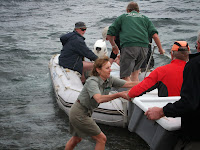HAUTURU / LITTLE BARRIER ISLAND
http://www.doc.govt.nz/parks-and-recreation/places-to-visit/auckland/hauraki-gulf-islands/little-barrier-island-nature-reserve-hauturu-o-toi
Friday 1st November
 Up at 6 am, dressed, breakfasted and at the DoC office by 7am. We were the first people processed through the quarentine room by the inspectors. They checked the velcro on our jackets, in our pockets and inside the soles of our boots to make sure we were not taking even a tiny, tiny weed seed. We left for the Leigh wharf to catch the Apollo to Hauturu. The sea was flat calm so it only took an hour to get over. There were 4 or 5 orca hunting around the mouth of the harbour!! Yay! At last I’ve seen a whale!
Up at 6 am, dressed, breakfasted and at the DoC office by 7am. We were the first people processed through the quarentine room by the inspectors. They checked the velcro on our jackets, in our pockets and inside the soles of our boots to make sure we were not taking even a tiny, tiny weed seed. We left for the Leigh wharf to catch the Apollo to Hauturu. The sea was flat calm so it only took an hour to get over. There were 4 or 5 orca hunting around the mouth of the harbour!! Yay! At last I’ve seen a whale!
.JPG) I stood up the the top watching the sooty shearwaters, flutterers, and Buller’s shearwaters sweeping above the waves. There are few landing places on Hauturu and the beach is entirely composed of smooth stones, quite difficult to pull a boat up on and hard to walk on.
I stood up the the top watching the sooty shearwaters, flutterers, and Buller’s shearwaters sweeping above the waves. There are few landing places on Hauturu and the beach is entirely composed of smooth stones, quite difficult to pull a boat up on and hard to walk on.
 We were met by the Rangers and their children, Mahina and Liam. We put our gear into the island packs and headed up the Hamilton Track with Lynn Hamilton as our extremely well informed guide. She comes from an original settler family and her father was a botanist and recorded a lot of the data on the island. The top peaks are out of bounds but we climbed quite high. Beautiful forest and many bird calls - kōkako, kakariki, kākā, robins/toutouwai, long tailed cuckoo,
We were met by the Rangers and their children, Mahina and Liam. We put our gear into the island packs and headed up the Hamilton Track with Lynn Hamilton as our extremely well informed guide. She comes from an original settler family and her father was a botanist and recorded a lot of the data on the island. The top peaks are out of bounds but we climbed quite high. Beautiful forest and many bird calls - kōkako, kakariki, kākā, robins/toutouwai, long tailed cuckoo,
 |
| Kākā |
 |
| Toutouwai/NZ robin |
piwakawaka, riroriro, white heads, hīhī, tīeke, tui, kereru, bellbird/korimako, a little yellow hammer and some we managed to see as well as hear. Most moved too fast to photograph but I managed to get a kākā, a bellbird and a toutouwai. Heaps of plants that Lynn knew all about. Some larger leafed than those on the mainland, like this korokia and taurepo.
 |
| Taurepo |
 |
| Korokia |
 |
| Mairehau |
It was a fantastic walk, little bit of rain but mostly fine. We walked along the Hamilton Valley and you could see where all the boulders on the beach had come from.
 |
| Koromiko |
 |
| Koromiko |
The DoC house and volunteer quarters are all built at Te Maraeroa where the last Māori families lived and gardened. We passed deep kumara pits high up on the ridges. There are atleast 7 pa sites around the coast and many more cultivation/kainga sites marked by pits, terraces and stone walls. Everything is under vegetation now.
Back down at the buildings we met some of the weeders that are living on the island for 3 months and the children showed us how they
feed the small tuatara babies they are raising. The tuatara have greatly reduced in numbers for some unknown reason and there are very few in the wild on the island now.
The island is completely predator free and it is almost weird being in a bush reserve without any traps! I’ve become indoctrinated to poison and trapping!
Leaving the island took us longer as the weather had clouded over and the wind picked up the chop on the water. We lost the dinghy twice and had to go back to retrieve it. I stayed up top as much as I could because I didn’t want to miss anything but it was cold and less sea birds around. You could see the Hen, Sail Rock and the Whangarei Heads looked like an island too. I could see the new marae as we passed Pa Beach and then
 |
| Robinson Crusoe - Liam style |
around Pa Point and into Leigh harbour.
Unloaded and into the cars by 6pm and home by just after 7pm. What a privilege and what a great day!































.JPG)




















